7 Cool Things from the Smart Cities Expo in Brooklyn
Clever trash cans, lighter bikes and observant street lights, all from the kickoff of a four-day conference at the Navy Yard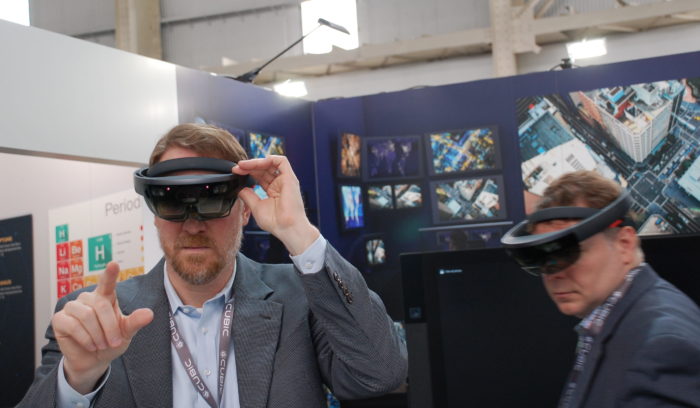
Dirck Schou, co-founder of Taqtile, demonstrates his mixed-reality software at the Smart Cities NYC '17 conference (Photos by Steve Koepp)
How can we make a city that runs better? Where subways get fixed promptly, epidemics get spotted in real time, street lights don’t waste energy, and cops know where the perps are hiding? In the digital era, a vast quantity of data becomes the raw material that can make all of this happen. Harnessing that information is the mission of the smart-cities movement, which comes together this week at the Brooklyn Navy Yard for a historic conference and expo.
Smart Cities NYC ’17 is drawing 2,000 attendees from 30 countries for four days of talks and demos for the stated mission of making the urban world “safer, smarter, more efficient, and more inclusive.” The planners had to be pretty smart themselves to orchestrate the intellectually sprawling event, not incidentally in Brooklyn, just as the borough is raising its profile in the conference business. “It’s very gratifying to see it all come together,” said Raj Pannu, CEO of Emergence Creative, one of the groups organizing the show. “It started out as a back-of-the-cocktail-napkin idea” two years ago, he said.
As the first of 150 speakers and 100 demonstrations got started today, experts talked about such issues as self-driving cars on busy streets and the threats to privacy in an all-knowing environment. Clearly, smart cities will have their controversies. Ruthbea Yesner Clarke, global director of smart cities for IDC Government Insights, raised the prospect of digital wearables communicating with a driver’s car. “There’s nothing I want less than an automaker to read my vital signs, but for some people with health issues, that may be comforting.”
In this bustling hub of smartness, The Bridge found seven cool early takeaways.
1. The formula for a livable city
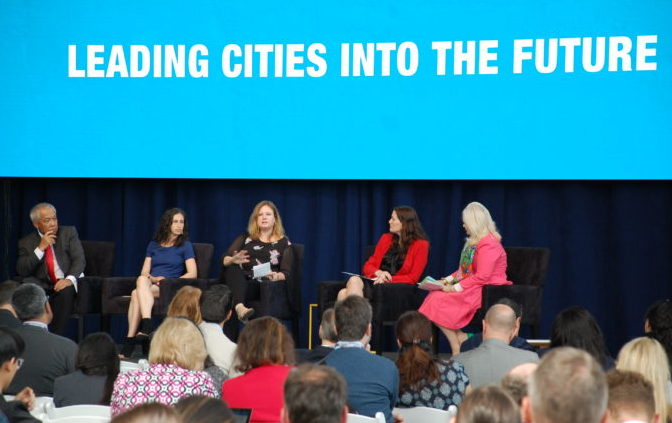
In a kickoff panel (above) called “Leading Cities Into the Future,” moderator Deborah Wince-Smith, CEO of the U.S. Council on Competitiveness, asked the panelists what makes a city livable. “I’d say the energy of a city. You see people of all different backgrounds,” said Stacey Gillett, who specializes in government innovation for Bloomberg Philanthropies. Compared with Washington, D.C., which she called “a one-sector town,” New York City is a place where “I could be sitting next to the richest billionaire and I wouldn’t know it.” Panelist Clarke added a twist: “I think cities need to develop their own brand of energy,” she said, citing Nashville. “It’s all the entertainment and fun that’s happening when you’re not working.” Asked to pick their favorite cities, the panelists named Sao Paolo (dynamism and soul), Copenhagen (health care, partying), Stockholm (parks, family leave), and Fukuoka (Japan’s Silicon Valley).
2. An information sponge on wheels
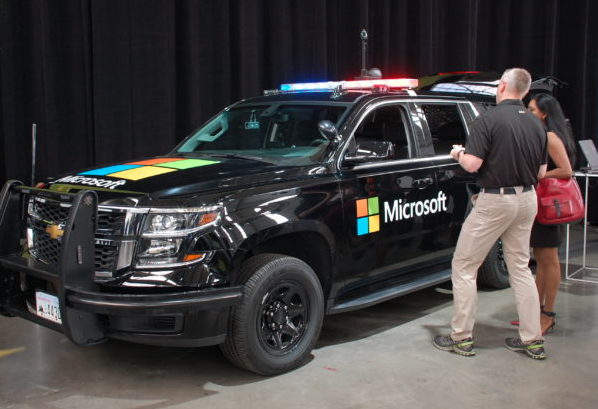
Looking like something Inspector Gadget might drive, the Microsoft Patrol Car bristles with digital devices supplied by its partners to create a “technology aggregator.” One of the key pieces is the VR-Eye Cam, a single-lens, spherical camera that is close to all-seeing. “If you drive this vehicle down the street, it can suck up all the data, with every pixel geo-referenced and time-stamped,” said Dave Bartell, director of special projects for Adcor Magnet Systems, which markets the camera system. Not only does the camera see in every direction, but it can transmit the data in real time over cellular networks, making it potentially a powerful tool for the military and law enforcement, said Bartell, a former Navy pilot.
3. A shareable bike built for comfort
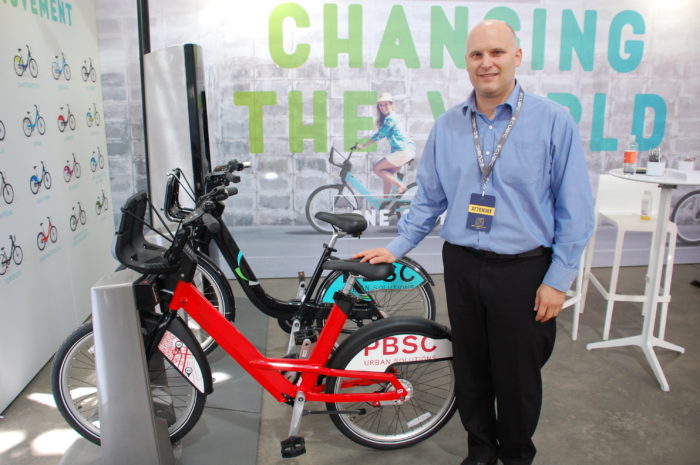
New Yorkers love their Citi Bikes, but at around 50 lbs., they’re no lightweights. PBSC Urban Solutions, the Quebec-based company that made Citi Bikes until the bike-share venture started building its own, is introducing a new bike-share model called the Fit (in red, above). The bike is about 10 lbs. lighter than the Citi Bike model, with 24-inch wheels vs. the original 26-inch. The lighter version, which will launch with 1,000 bikes in Honolulu this year, is also about 20% less expensive to buy, making it affordable for more cities. Later this year, PBSC will launch the Boost model, an electric-assist bike that helps riders deal with steep hills and headwinds, said Gian-Carlo Crivello, client relationship officer (above). So far, the company has sold 50,000 units of its Iconic model, on which the current Citi Bike is based.
4. A street light that’s watching over things
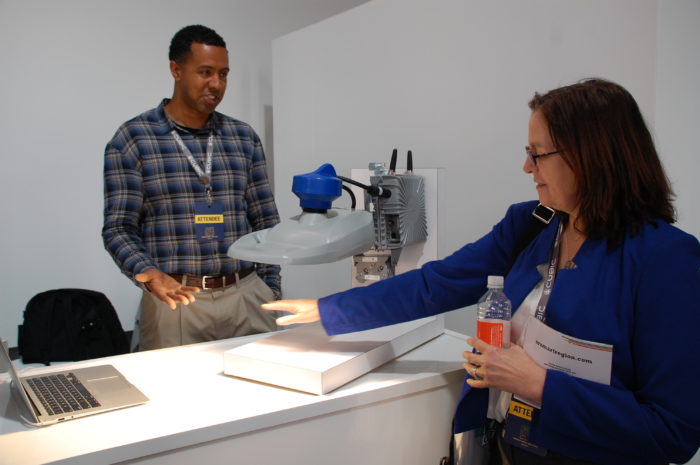
What most of us know about street lights is that they have an electric eye that turns them on and off. But what if they could do more? Verizon, which shows every sign of wanting to become more than a phone company, last year bought the company Sensity Systems, which makes so-called Light Sensory Networks. As 4 billion lights worldwide are changed over to LED systems in the next few years, this will be big business. Destah Owens (above), who demonstrated a smart streetlight at the Navy Yard expo, said the lights can measure such things as temperature, air quality, humidity, snow depth, and human activity around the light. The data can be used for saving energy by turning the lights up or down when needed, but also for cities to have a better feel for the urban landscape, block by block.
5. Weapons that remember what happened
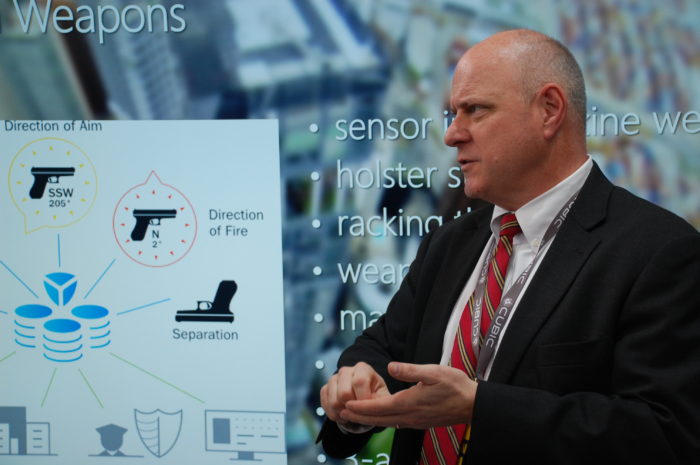
Microsoft displayed an array of law-enforcement tools, including sensors that turn on police body cams when officers unholster their guns, and accelerometers that do likewise when officers move suddenly, as in a chase. The program, called Connected Weapons, can record the direction in which police aim their guns, the loss of a weapon, and other factors. “It creates a 360-degree recreation of any incident,” said Richard Zak, director of Justice & Public Safety Solutions for Microsoft, above.
6. Not just another dumb trash can

A delicate act of urban life is placing that last empty coffee cup on top of an overflowing trash can. The ones on busy corners runneth over, while other ones get emptied whether they need it or not. Victor Stanley, a Maryland “site furniture” company, offers the Relay, a “street level sensing & waste control service.” The system monitors the fill level and weights of a city’s containers so they can be collected at the optimal time. The well-timed pickups not only reduce the mess but also save an estimated 20% to 40% in collection expenses. The batteries on those trash cans last an estimated six years.
7. Look over your domain with a bird’s-eye view
https://www.youtube.com/watch?v=-6p1UJn3eNY
When viewed through the mixed-reality Microsoft HoloLens, the skyline of Seattle comes into three-dimensional view. Powered by software from Taqtile, the city view can be overlaid with all sorts of information, including real-time traffic patterns, weather forecasts, and geo-tagged Twitter feeds. Dirck Schou, co-founder of Seattle-based Taqtile, demonstrated how multiple users could collaborate in real time viewing the same 3D experience. The company deployed its technology for a golf app (above) and a project with the Cleveland Cavaliers to create a virtual holographic walkthrough of proposed renovations to the Quicken Loans Arena.













